Motorola Droid 3 Review - Third Time's a Charm
by Brian Klug on July 30, 2011 12:01 AM ESTBattery Life
Of course the next question is how battery life fares, after all, it doesn’t matter too much in a mobile device if we have great application performance but need to be tethered to a charger all day long. Back to those Cortex-A9s, the next part of the picture is what power management features are and aren’t supported. First off, OMAP4 is a synchronous architecture, which means that there’s one frequency plane for both A9s - each runs at the same clock. Both can be clock gated, however.
The important next bit is that each CPU is on its own power domain. The power states of each CPU doesn’t have to be the same, and OMAP4 supports three modes - Normal (run), dormant, and power off. You can see the different power domains as illustrated by the following diagram.
TI also provides a nice table with the supported power states and clock gating states depending on what assertions are made in the local power control module register.
What’s particularly interesting is that we can actually watch cores turn on and off both through console output on the device (by running something like dmesg) and moreover there’s even some nice software that will show us graphically. System Panel (which I’m a pretty big fan of) recently added support for visualizing load on multicore Android devices, and you can see how things fare when there’s both idle activity (CPU1 gets shut completely off), and when I’m generating tons of load by flicking the page around wildly (both CPUs are on, and clocked at 1.0 GHz).
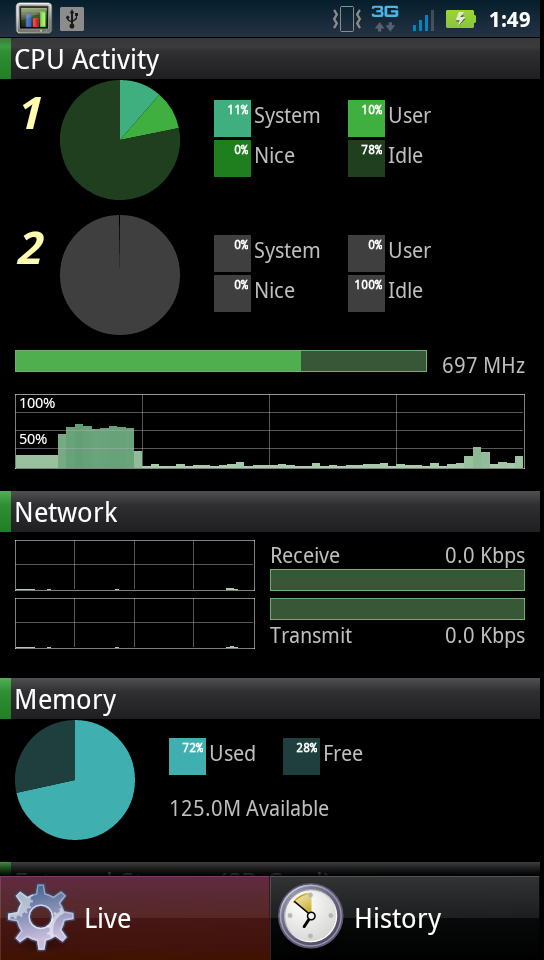
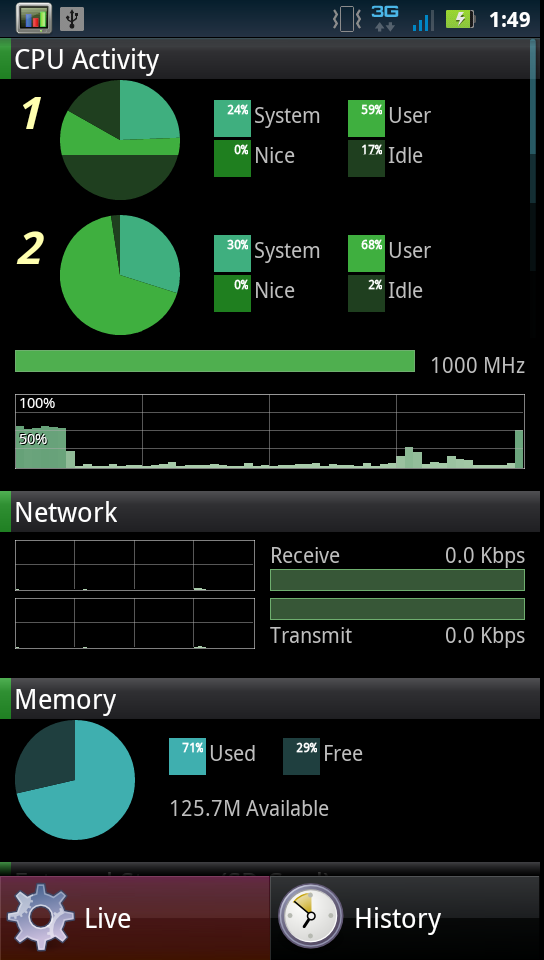
Like most modern SoCs, OMAP4 can dynamically change frequency, however it also can dynamically change voltage with a power management technique called SmartReflex. There are two different modes for SmartReflex, one which consists of an entirely hardware-controlled voltage control loop (class 3) and another which is assisted using software control (class 2). I’ve verified that the Droid 3 is using class 3:
“<6>[ 0.000000] SmartReflex CLASS3 initialized”
SmartReflex encompasses both the dynamic frequency, voltage, and power switching functions on the OMAP4430. The aim is to use silicon in the best way possible depending on either static silicon performance (given manufacturing) or dynamically based on temperature induced performance, and raise or lower voltage accordingly. To a large extent, SmartReflex it somewhat analogous to Intel’s SpeedStep and related suite, and in OMAP5 even gains a turbo mode which allows the SoC to temporarily exceed its normal maximum clock.
Now that we’ve gone over the power features of OMAP4, it’s time to present some Droid 3 specific battery life results. As usual, we’ve run our battery life testing suite on the device. The first set of tests are our page loading suite, which load through a few dozen pages every 10 seconds or so until the phone dies. The backlight brightness is at 200 nits and of course always on, to mimic continual web browsing.
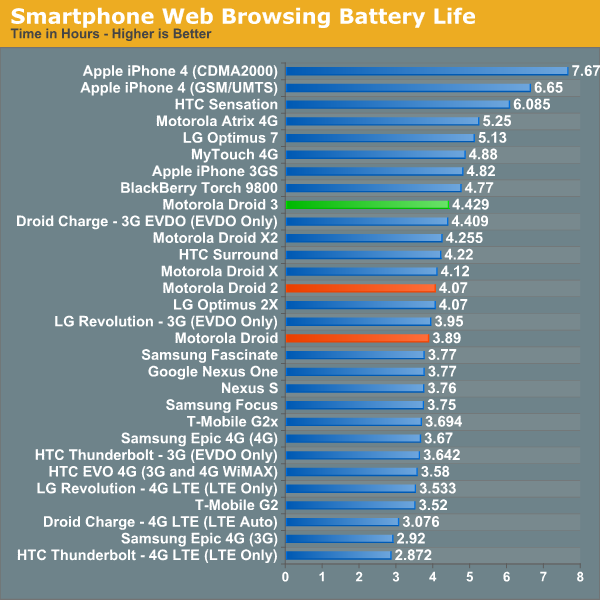
The Droid 3 both brings improvements in performance and display resolution alongside better battery life for smartphone web browsing. The other interesting performer to keep eye on is the Droid X2, which includes the same sized battery and baseband (MDM6600), but Tegra 2.
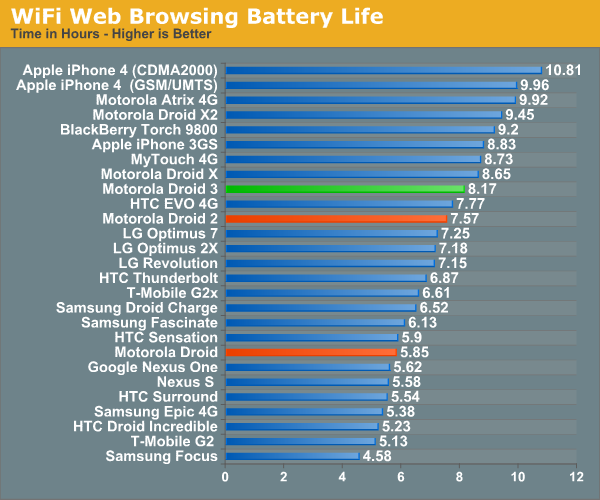
Next up is WiFi web browsing, where we run the same test but using WLAN instead of cellular connectivity. Here we can’t compare to the Droid X2 anymore as there are different WLAN stacks in each, but the Droid 3 continues to outperform its predecessors.

Motorola continues to somehow have a secret sauce for continually delivering incredibly long call time battery life, with now five spots dominated by Motorola devices. I’m still at a loss for exactly what they’re doing that gives them such a leg up, but it’s considerable.
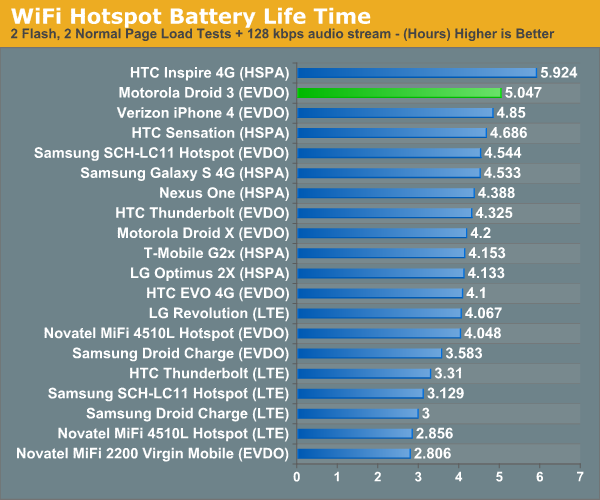
Finally is the WiFi hotspot battery test, which consists of a single WLAN client loading four tabs of our page loading test (two with flash content, two without), and a 128 Kbps MP3 streaming internet radio station. The display on the device is off the whole time. It’s a heavy test that mimics continual use and keeps everything awake on the device.
Here the Droid 3 does very well, though we don’t have any comparison data from the Droid 2 or Droid 1 due to this being a newer test. The overall results definitely illustrate the potential power savings of a dual core architecture - to put it in Anand’s words, you just can’t beat voltage scaling when dealing with power.


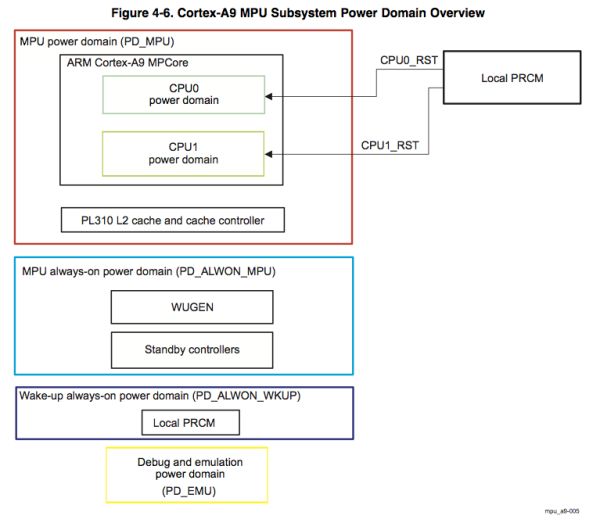
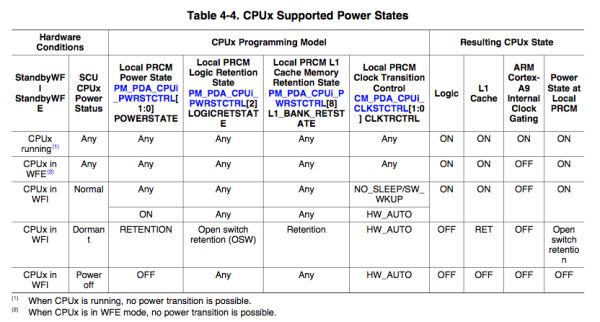








84 Comments
View All Comments
Brian Klug - Sunday, July 31, 2011 - link
Anand is still working on it, he's been super busy but hopefully it's next in his pipeline. ;)-Brian
vision33r - Sunday, July 31, 2011 - link
Using a gimmick technology to upsize the resolution cheaply. Having used the Atrix for almost 6 months I am sick of looking at it. Luckily it was for work.Looking at Pentile LCD for a long time is almost like watching a 3D movie without the glasses on. Your vision starts to strain and you will see the colors around the font.
FAIL/.
kesh27 - Sunday, July 31, 2011 - link
Seems like a lot of negativity toward the type of display. I have a D2G I like a lot and will likely upgrade to this or something very close months down the road. Sweet the D3 doesn't require a fork and incorporates global use (minus the US carrier lockout).Perhaps a little more subjective review of the new display, such as fatigue or annoyance after watching 30m of video or continuous use of a variety of apps? Maybe a small panel review of something similar to balance opinion?
As to hackability, I bought a G1 when they first came out and had it strung out on Cyanogen as far as hardware could take it, only because OTA updates weren't every coming from T-Mo. Finally got a global phone with specs I wanted for future travel. Have honestly had no need to do any hacking other than a root for Titanium Backup (freezing bloatware), ok maybe occasional wifi tether too. If you want a phone to hack, get a hackable phone. I like this line because it runs everything I want very well, and keyboards rule.
synaesthetic - Sunday, July 31, 2011 - link
Man, screw you Moto. Bunch of effin' liars.UNLOCK IT NAO. And the one on the Droid X2 also!
Undersea - Sunday, July 31, 2011 - link
Might be silly to some but coming from blackberry which I could sort email to droid 1 which I couldn't, I hope to heck you can sort outlook emailhillsurfer - Monday, August 1, 2011 - link
We just upgraded my wife's line to the Droid 3, and the fact that it isn't LTE is one reason we chose it. We still have the unlimited 3G data plan, which we'd have to give up if we switched to LTE, which isn't available in this area anyway, and won't be for some time.Just wanted to point out that some "improvements" come with a price. Luckily, Motorola and Verizon Wireless didn't include LTE as an improvement. I suspect we won't have that choice much longer.
funoptics - Monday, August 1, 2011 - link
Great review, AnandTech! It could be top notch, however, if you included the only thing that seemed to be missing: a discussion of the performance and capabilities of the motion sensors. Some smart phones have gyros, the Droid 3 does not. For users of smartphones working with augmented reality applications, this is very important.photoguru - Monday, August 1, 2011 - link
One thing that most people have overlooked is the fact that they put a 16GB card hardwired in it and also gave us a card slot for a second card! I loaded mine up with 48GB of class 10 storage goodness :)nitink - Monday, August 1, 2011 - link
this phone have a great potential unleach its power get full hd games with sd card data..at:http://nitin-xyz.blogspot.com/2011/07/free-and-ful...
araczynski - Monday, August 1, 2011 - link
I had the first droid for about a year when it first came out, found the keyboard sliding mechanism to be a joke. poorly engineered, namely due to easily trapping dust/fine particles of sand (or gold;)), and the rail mechanism just wearing away at the back surface, making it look cheap and abused after only a few uses.would never use another phone that uses the same engineering, which this seems to be just like.
i like my droid x at the moment, much nicer screen, and i'll take the onscreen keyboard over worthless sliding any day.